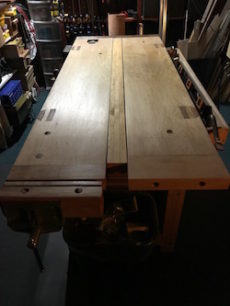That Spanish style chest I made after returning from Paris was a project that had been on my mind for a long time.
There have been a few times where I started out to make the chest. Instead, I made something else, again and again. My mind was not aligned with this project and I just didn’t know what was holding me back.
I realized that I was fearful of making a furniture piece in a traditional style. I questioned myself. Do I know enough? My aim was that all of the elements – joinery, finishing, and hardware – would make it a brilliant collectors piece.
But I was making a modern piece with modern materials in my style. I did not have a desire to age or antique the piece. I am certain that most of the old woodworkers and carpenters did not beat, scrape or chip their work. No, I am not certain they didn’t!
Should I be indebted to old furniture?
An old piece of furniture like a Spanish chest evokes a feeling of comfort, history, and memory. Authentic pieces with pedigree or age are a collector’s dream. They bring money and recognition from those collectors and institutions – not so for the creator.
Tyrannical entreaties (often from non-creators) to adhere to “tradition” poison the well of creativity and derail the future. It is evident who is not the beneficiary of such demands.
Do I owe homage? Does any of it deserve a measure of reverence from me as a woodworker or woman of culture? Does it matter? I imagine anything is good enough to hold a pair of socks or childhood treasures.
Spanish chest: flattery or appropriation?
Museums, palaces, great buildings, and other repositories of antiquities have custody of presumably important pieces of furniture and other architectural elements.
Other than for items that have restricted access, I can study, research, and try to associate how such pieces originated.
One thing leads to the other and I do end up learning the history of a piece. I’ve unearthed information that is enlightening and horrifying and everything in between.
Design – carpentry, furniture-making, joinery, architecture, all of it – is influenced by the times. By studying those times, the alignment of prevailing societal and historical events and its influence on creativity is always revealed.
The effect of invasions, war, demographic change, decolonization, continuing demands for individual and collective rights and the thoughtless push-back to same, do not occur in a vacuum. Time is telling.
Thus the question is why conceal the origin, purpose, or true artisans which eventually must be and will be revealed? This explains why storytelling and the ability and authority to do so, in order to value-weight history is more important – for those same non-creators – than food.
What do you do when you find that something you admire from history originated out of cruelty or unimaginably inhumane acts? Sometimes, it takes a bit of critical thinking and strength, psychologically and spiritually, to bear witness to it all.
I know in my heart that I could never replicate anything along exact lines. I couldn’t.
For me, the weight of appropriation and respect for all cultures is ever present. Interest goes where it goes. I am as respectful as my knowledge – subject to revision – allows.
Borrowing from my ancestors
There is another issue that I deal with regarding appropriation in woodworking. I am a descendant of African furniture builders and master carpenters brought to this country to toil and die.
Concerning the works of African people, history has not been kind.
It is evident that the skills I possess derive from the spiritual transference of knowledge from those sacred beings.
I have never lived in Africa. The unknown ancestral villages that yielded my own mother and father are just that – unknown. I have not been schooled or slept one night under the African skies.
As much as I would like to create authentic African woodworking pieces, I cannot.
I may replicate or copy some aspects of the pieces as evidence of my admiration as an artist and my love as a descendent. The work is done with respect. No conscious offense is given.
Still, I imagine it could be a form of appropriation. How so? There is a spiritual and cultural element that I have not experienced in that place – in person.
Yes, I am a Black woman descended from African people. Perhaps I don’t feel worthy in that sense. I am confident that the craftswomen or craftsmen who live in the homeland today will lead us toward the rediscovery of our ancient gifts of creation and innovation.
Maybe one day I will have the opportunity to learn from a master in that place.
While knowledge building, I create in order to honor those prime originators – my progenitors. I do so as respectfully as my skills allow.
A Life of Discernment
I am a woodworker, artist, and human. My work is not created in a self-imposed vacuum to the world. The steps into and out of my shop are a significant part of my pilgrimage on this earth. Every action, good and bad, is on record in the book of life, never to be erased. And I never want it to be.
I am a woodworker. Well, I am while I’m writing this and creating anything else. In and out of the shop, I evaluate, dissect, amplify, and even, err. Each step counts for something good.
On my way to solace and healing, my camino, I rise to face fear. In my woodspace, I turn creative obstacles into thoughtful, beautiful things. My tools, bench, and skills support me in making this offering…
Wait!!! I said that last time.
Ok. This time I start this Spanish style chest in earnest.

This was part 1 of a 4 part series.
Up next is the beginning of the build for the Spanish Style Chest – part 2.
💚S
